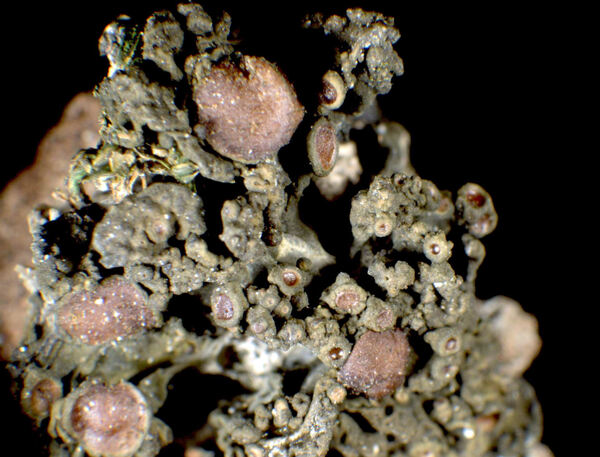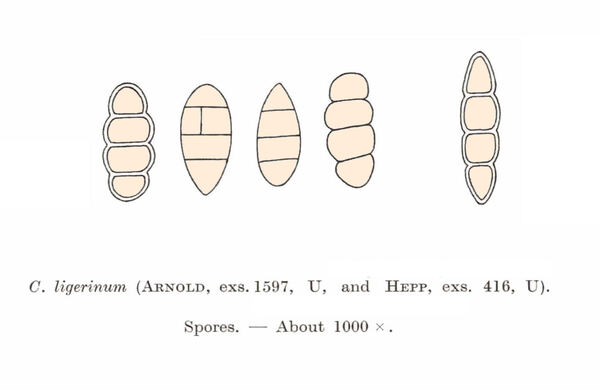Enchylium ligerinum (Hy) Otálora, P.M. Jørg. & Wedin
Fungal Divers., 64, 1: 286, 2013. Basionym: Collema pulposum var. ligerinum Hy - Mèm. Soc. Nat. Agricult. Sc. Arts Angers: 24, 1893.
Synonyms: Collema ligerinum (Hy) Harm.; Collema verruculosum auct. p.p.; Lathagrium conglomeratum sensu A. Massal.; Leptogium verruculosum (A. Massal.) Jatta
Description: Thallus small-foliose to subsquamulose, homoiomerous, gelatinous and 150-550 µm thick when wet, forming 5-10(-16) mm wide cushions. Lobes few, 0.5-1.5(-2) mm wide, flattened, adpressed to erect, usually branched, distinctly swollen, sometimes with adventive lobules. Upper surface dark olive-green to brown or black, dull, epruinose, without isidia; lower surface usually paler bluish grey, with scattered white hapters. Upper and lower cortices absent. Apothecia common, lecanorine, numerous and crowded on lobe margins or terminal and often hiding the lobes, sessile and constricted at base, 0.5-1(-2) mm across, with a concave to flat, dark reddish brown disc and a rather thick, but finally often excluded, entire, smooth thalline margin. Thalline exciple ecorticate; proper exciple euthyplectenchymatous; epithecium brownish; hymenium colourless, 85-105 µm high, I+ blue; paraphyses simple or sparingly branched, 2-3 µm thick at mid-level, the apical cells clavate, up to 4.5 µm wide; hypothecium yellowish. Asci 8-spored, cylindrical-clavate, the apex strongly thickened, the apical dome K/I+ pale blue, with a downwardly projecting K/I+ deep blue tubular structure. Ascospores 3-septate, hyaline, oblong or ovoid with usually rounded ends, sometimes slightly constricted at septa, (14.5-)17-24 x 6-8.5 µm. Pycnidia common, mostly marginal, immersed, globose, paler than thallus. Conidia bacilliform, slightly swollen at both ends, 4.5-5 x c. 1 µm. Photobiont cyanobacterial (Nostoc, the cells in long chains). Spot tests: all negative. Chemistry: without lichen substances.
Growth form: Foliose, narrow lobed
Substrata: bark
Photobiont: cyanobacteria, filamentous (e.g. Nostoc, Scytonema)
Reproductive strategy: mainly sexual
Commonnes-rarity: (info)
Alpine belt: absent
Subalpine belt: absent
Montane belt: absent
Dry submediterranean belt: very rare
Humid submediterranean belt: very rare
Padanian area: extremely rare
pH of the substrata:
1 2 3 4 5
Solar irradiation:
1 2 3 4 5
Aridity:
1 2 3 4 5
Eutrophication:
1 2 3 4 5
Poleotolerance:
0 1 2 3
Altitudinal distribution:
1 2 3 4 5 6
Rarity
absent
extremely rare
very rare
rare
rather rare
rather common
common
very common
extremely common
Loading data...
Occurrence data
Predictive map
Growth form: Foliose, narrow lobed
Substrata: bark
Photobiont: cyanobacteria, filamentous (e.g. Nostoc, Scytonema)
Reproductive strategy: mainly sexual
Commonnes-rarity: (info)
Alpine belt: absent
Subalpine belt: absent
Montane belt: absent
Dry submediterranean belt: very rare
Humid submediterranean belt: very rare
Padanian area: extremely rare
pH of the substrata:
| 1 | 2 | 3 | 4 | 5 |
Solar irradiation:
| 1 | 2 | 3 | 4 | 5 |
Aridity:
| 1 | 2 | 3 | 4 | 5 |
Eutrophication:
| 1 | 2 | 3 | 4 | 5 |
Poleotolerance:
| 0 | 1 | 2 | 3 |
Altitudinal distribution:
| 1 | 2 | 3 | 4 | 5 | 6 |
Rarity
absent
extremely rare
very rare
rare
rather rare
rather common
common
very common
extremely common
Loading data...
Occurrence data
Predictive map








